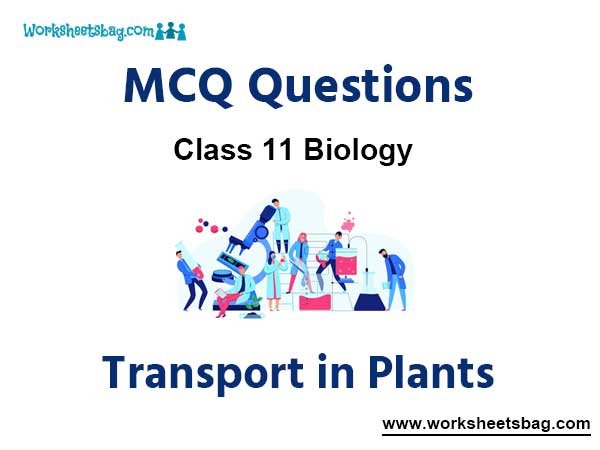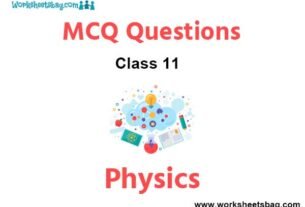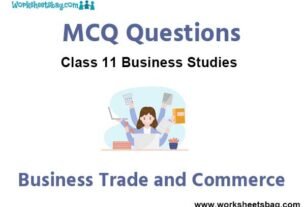Please refer to Transport in Plants MCQ Questions Class 11 Biology below. These MCQ questions for Class 11 Biology with answers have been designed as per the latest NCERT, CBSE books, and syllabus issued for the current academic year. These objective questions for Transport in Plants will help you to prepare for the exams and get more marks.
Transport in Plants MCQ Questions Class 11 Biology
Please see solved MCQ Questions for Transport in Plants in Class 11 Biology. All questions and answers have been prepared by expert faculty of standard 11 based on the latest examination guidelines.
MCQ Questions Class 11 Biology Transport in Plants
Question- A boy is studying transport of a certain type of molecules into cell. He finds that transport slows down when the cells are poisoned with a chemical that inhibits energy production. Under normal circumstances the molecules studied by the boy is probably transported by
(a) simple diffusion
(b) osmosis
(c) active transport
(d) facilitated diffusion
Answer
C
Question- The process in which water moves out of the cell and the cell membrane of a plant cell shrinks away from its cell wall is known as
(a) diffusion
(b) osmosis
(c) plasmolysis
(d) bulk flow
Answer
C
Question- Which of the following statement is incorrect regarding stomata?
(a) It helps in exchange of oxygen and carbon dioxide in the leaf.
(b) It is open in the day time and close during the night.
(c) Opening or closing of the stomata is a change in the turgidity of the guard cells.
(d) The inner wall of each guard cell, towards the stomatal aperture is thin and rigid.
Answer
D
Question- When a cell is plasmolysed, it becomes
(a) flaccid and its TP becomes zero.
(b) turgid and its TP becomes zero.
(c) turgid and TP becomes equal to OP.
(d) flaccid and DPD becomes zero.
Answer
A
Question- Which of the following statements is/are not incorrect?
(i) Water and minerals, and food are generally moved by a mass or bulk flow system.
(ii) Bulk flow can be achieved either through a positive hydrostatic pressure gradient or a negative hydrostatic pressure gradient.
(iii) The bulk movement of substances through the conducting tissues of plants is called translocation.
(iv) Xylem translocates organic and inorganic solutes, mainly from roots to the aerial parts of the plants.
(v) Phloem translocates water, mineral salts, some organic nitrogen and hormones, from the leaves to other parts of the plants.
(a) (ii), (iii) and (v)
(b) (ii), (iii) and (iv)
(c) (iv) and (v)
(d) (ii) and (v)
Answer
C
Question- During fruit development, photosynthesizing leaves would be the __________ and the fruit would be __________
(a) sink, sink
(b) source, source
(c) sink, source
(d) source, sink
Answer
D
Question- The process by which water is absorbed by solids like colloids causing them to increase in volume is called _______.
(a) osmosis
(b) plasmolysis
(c) imbibition
(d) diffusion
Answer
C
Question- Casparian strip is made up of
(a) lignin
(b) pectin
(c) suberin
(d) cellulose
Answer
C
Question- The following statements are associated with translocation of mineral ions.
(i) Mineral ions are slowly remobilised.
(ii) Younger leaves export most of their minerals content to older leaves.
(iii) Elements most readily mobilised are P, S, N and K.
(iv) Some elements that are structural components like calcium are not remobilised.
Which of the above statements are correct?
(a) (i) and (iii)
(b) (i) and (ii)
(c) (iii) and (iv)
(d) (ii) and (iii)
Answer
C
Question- Which of the following organism helps in the absorption of water and mineral ions from the soil?
(a) Nostoc
(b) Anabaena
(c) Mycorrhiza
(d) Spirullina
Answer
C
Question- Cell A and cell B are adjacent plant cells. In cell A,ys = – 20 bars and yp = 8 bars. In cell B, ys = – 12 bars and yp = 2 bars. Then
(a) water moves from cell A to cell B.
(b) there is no movement of water between cell A and cell B.
(c) water moves from cell B to cell A.
(d) equal amount of water is simultaneously exchanged between cell A and cell B.
Answer
C
Question- Which of the following is the most acceptable theory for movement of water through plants?
(a) Cohesion theory
(b) Passive transport
(c) Root pressure
(d) Capillarity
Answer
A
Question- Seed increase in its volume by the absorption of water through
(a) osmosis
(b) diffusion
(c) imbibition
(d) plasmolysis
Answer
C
Question- Match column-I with column-II and find out the correct answer from the code given below.
Column-I Column -II
A. Diffusion I. Hydrophilic substances
B. Osmosis II. Shrinkage of protoplasm
C. Imbibition III. Semipermeable membrane
D. Plasmolysis IV. Free movement of ions and gases
(a) A – II; B – I; C –IV; D – III
(b) A – IV; B – III; C – I; D – II
(c) A – III; B – I; C – IV; D – II
(d) A – II; B – III; C – IV; D – I
Answer
B
Question- Read the given statement and answer the question :
“Osmosis is the diffusion of a solution of a weaker concentration when both are separated by semipermeable membrane”.
What is the error in the statement ?
(a) The movement of solvent molecule is not specified.
(b) There is no mention of DPD.
(c) Behaviour of semipermeable membrane is not specified.
(d) The exact concentration of solutions are not indicated.
Answer
A
Question- Which of the following wall of guard cells is thick?
(a) Side wall
(b) Middle wall
(c) Inner
(d) Outer
Answer
C
Question- Movement that is aided by cytoplasmic streaming and occurs from cell to cell through plasmodesmata is called________.
(a) apoplast
(b) symplast
(c) active transport
(d) translocation
Answer
B
Question- Osmosis is a form of diffusion in which
(a) the solvent moves through a semipermeable membrane from its region of higher chemical potential to its region of lower chemical potential.
(b) the solvent moves through a semipermeable membrane from its region of lower chemical potential to its region of higher chemical potential.
(c) the solute moves through a semipermeable membrane from a region of higher concentration to lower concentration.
(d) the solute moves through a semipermeable membrane from a region of lower concentration to higher concentration.
Answer
D
Question- Which of the following factors affect transpiration?
(i) Number and distribution of stomata.
(ii) Percent of open stomata.
(iii) Water status of the plant.
(iv) Canopy structure.
(a) (i) and (ii)
(b) (i), (ii) and (iii)
(c) (ii) and (iv)
(d) (i), (ii), (iii) and (iv)
Answer
D
Question- Translocation of food in flowering plants occurs in the form of
(a) starch
(b) glyceraldehyde
(c) glucose
(d) sucrose
Answer
D
Question- Match the name of the activities given under column-I with the description of activity given under column-II and choose the correct option.
Column-I Column-II
A. Cohesion I. The ability to rise in their tubes.
B. Adhesion II. Loss of water vapour from plant parts.
C. Tensile strength III. Mutual attraction between water molecules
D. Capillarity IV. Attraction of water molecules to polar surfaces
V. An ability to resist a pulling force.
(a) A – I; B – II; C – III; D – V
(b) A – II; B – I; C – IV; D – III
(c) A – III; B – IV; C – V; D – I
(d) A – IV; B – V; C – II; D – III
Answer
C
Question-Which of the following pairs of the cell structures are important for determining the movement of molecules in or out of the plant cell?
(a) Tonoplast + Vacuolar membrane
(b) Tonoplast + Cell membrane
(c) Cell wall + Cell membrane
(d) Cell wall + Tonoplasts
Answer
C
Question- Bidirectional translocation of minerals takes place in
(a) xylem
(b) phloem
(c) parenchyma
(d) cambium
Answer
B
Question- Guttation is loss of impure water which is the result of
(a) osmosis
(b) diffusion
(c) root pressure
(d) transpiration
Answer
C
Question- _______is mainly water and sucrose, but other sugars, hormones and amino acids are also _______ through phloem.
(a) xylem sap, loaded
(b) phloem sap, translocated
(c) xylem sap, translocated
(d) phloem sap, loaded
Answer
B
Question- The force responsible for upward conduction of water against gravity comes from _______.
(a) transpiration
(b) translocation
(c) respiration
(d) photosynthesis
Answer
A
Question- Water in the adjacent xylem moves into the phloem by the process of
(a) facilitated diffusion
(b) acute transport
(c) simple diffusion
(d) osmosis
Answer
D
Question- When a root absorbes minerals from a region of lower concentration to a region of higher concentration, and need energy then this type of absorption is called
(a) passive absorption
(b) facilitated diffusion
(c) active absorption
(d) osmosis
Answer
C
Question- Phloem tissue is composed of sieve tube cells, which form long columns with holes in their end walls called ______.
(a) tracheids
(b) sieve elements
(c) sieve plate
(d) companion cell
Answer
C
Question- In root endodermis there is one way active transport of ions because of presence of
(a) pericycle
(b) suberin layer
(c) cortex
(d) cellulosic layer
Answer
B
Question- The net direction and rate of osmosis depends on both the ‘X’ and ‘Y’. Identify ‘X’ and ‘Y’.
(a) X – Solute; Y – Solvent
(b) X – Pressure potential; Y – Solute potential
(c) X – Water potential; Y – Pressure gradient
(d) X – Pressure gradient; Y – Concentration gradient
Answer
D
Question- The hypothesis accepted for the translocation of sugar from source to sink is__________.
(a) pressure gradient
(b) pressure flow hypothesis
(c) mass flow hypothesis
(d) both (b) and (c)
Answer
D
Question- Which of the following statement is correct?
(a) Unlike water, all minerals cannot be passively absorbed by roots.
(b) Most of the minerals enter the root by active transport.
(c) Ions are absorbed from soil by both passive and active transport.
(d) All of the above
Answer
D
Question- In a fully turgid cell
(a) ys will be negative and yp will be positive.
(b) yp will be negative and ys will be positive.
(c) Both yp and ys will be positive.
(d) Both ys and yp will be negative.
Answer
A
Question- Which of the following statements is/are correct?
(i) The apoplastic movement of water occurs exclusively through the cell wall without crossing any membranes.
(ii) The apoplastic movement occurs from cell to cell through the plasmodesmata.
(iii) Endodermis is impervious to water because of a band of suberised matrix.
(iv) Symplastic movement may be aided by cytoplasmic streaming which occurs in Hydrilla leaf and chloroplast.
(a) (i) and (ii)
(b) (ii) and (iv)
(c) (i), (iii) and (iv)
(d) (i), (ii) and (iv)
Answer
C
Question- Guard cells help in
(a) protection against grazing
(b) transpiration
(c) guttation
(d) fighting against infection
Answer
B
Question- Which of the following statements, (i -v) regarding transpiration is/are correct?
(i) It creates transpiration pull for absorption and transport of plants.
(ii) It supplies water for photosynthesis.
(iii) It transports minerals from the soil to all parts of the plants.
(iv) It heats leaf surfaces, sometimes 10 to 15 degrees.
(v) It maintains the shape and structure of the plants by keeping cells turgid.
(a) Only (ii)
(b) Only (iii)
(c) (i), (ii), (iii) and (v)
(d) All
Answer
C
Question- A cell swells up when kept in
(a) hypotonic solution
(b) hypertonic solution
(c) isotonic solution
(d) any of the three
Answer
A
Question- At which cell layer, water movement through the apoplast pathway is restricted and is facilitated towards symplast pathway?
(a) Cortex
(b) Pericycle
(c) Epidermis
(d) Endodermis
Answer
D
Question- Phenomenon of plasmolysis occurs when
(a) cells are kept in hypertonic solution.
(b) cells are kept in hypotonic solution.
(c) cells are kept in hypotonic solution.
(d) none of the above.
Answer
A
Question- Match the name of the activities given under column-I with the description of activity given under column-II and choose the correct option.
Column-I Column-II
A. Transpiration I. Anaerobic respiration in yeast
B. Guttation II. Active absorption of water
C. Exudation III. Loss of water vapour from plant parts
D. Fermentation IV. Loss of liquid water from leaves
V. Loss of water from injured plant parts
(a) A – I; B – II; C – III; D – V
(b) A – II; B – I; C – IV; D – III
(c) A – III; B – IV; C – V; D – I
(d) A – IV; B – V; C – II; D – III
Answer
C
Question- The process of loading at the source produces a_________. condition in the phloem.
(a) hypertonic
(b) isotonic
(c) hypotonic
(d) hydroponic
Answer
A
Question- Bulk flow of substances over the longer distances through the vascular tissue is called
(a) simple diffusion
(b) facilitated diffusion
(c) active transport
(d) translocation
Answer
D
Question- Which of the following the statements regarding mycorrhizae is incorrect?
(a) Mycorrhizal fungi form a network around the young root and they penetrate the root cells.
(b) Mycorrhizae helps the plant to absorb water and minerals.
(c) Root provides sugar and nitrogenous organic compounds to the mycorrhizae.
(d) Pinus seed can germinate and establish without mycorrhizae.
Answer
D
Question- A plant cell placed in pure water will
(a) expand until the osmotic potential or solute potential reaches that of water.
(b) becomes more turgid until the pressure potential of cell reaches its osmotic potential.
(c) become more turgid until osmotic potential reaches that of pure water.
(d) becomes less turgid until the osmotic potential reaches that of pure water.
Answer
B
Question- Water will move from its region of higher chemical potential to its region of lower chemical potential until
(a) equilibrium is reached.
(b) amount of both solvent and solute in both regions become equal.
(c) solvent amount in both regions become equal.
(d) solute amount in both regions become equal.
Answer
A
Question- Find out the incorrect statements.
(a) The process of plasmolysis is usually irreversible.
(b) The pressure exerted by the protoplasts due to entry of water against the rigid walls is called yp.
(c) The T.P. is responsible for enlargement and extension growth of cells.
(d) Plant cells swell in hypotonic solutions.
Answer
A
Question- Sinks are related to
(a) transport of minerals
(b) stomata
(c) hydathodes
(d) phytochrome
Answer
A
Question- Bacteria cannot survive in a highly salted pickle because
(a) salt inhibits reproduction of bacteria.
(b) they become plasmolysed and death occurs.
(c) nutrients in pickle cannot support life.
(d) enough light is not available for photosynthesis.
Answer
B
Question- A pressure that is responsible for pushing up water to small height in the stem is called
(a) positive root pressure
(b) turgor pressure
(c) pressure gradient
(d) negative root pressure
Answer
A



